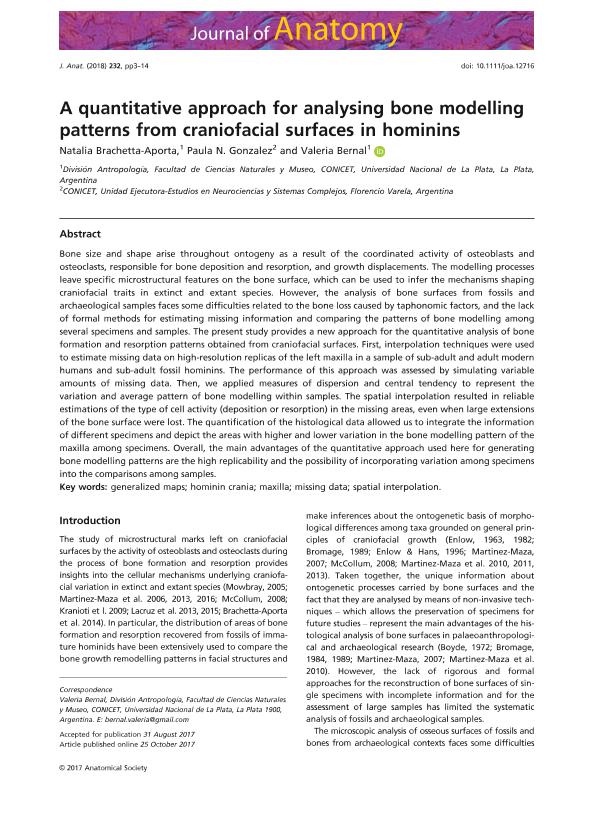Artículo
A quantitative approach for analysing bone modelling patterns from craniofacial surfaces in hominins
Fecha de publicación:
01/2018
Editorial:
Wiley Blackwell Publishing, Inc
Revista:
Journal of Anatomy
ISSN:
0021-8782
Idioma:
Inglés
Tipo de recurso:
Artículo publicado
Clasificación temática:
Resumen
Bone size and shape arise throughout ontogeny as a result of the coordinated activity of osteoblasts and osteoclasts, responsible for bone deposition and resorption, and growth displacements. The modelling processes leave specific microstructural features on the bone surface, which can be used to infer the mechanisms shaping craniofacial traits in extinct and extant species. However, the analysis of bone surfaces from fossils and archaeological samples faces some difficulties related to the bone loss caused by taphonomic factors, and the lack of formal methods for estimating missing information and comparing the patterns of bone modelling among several specimens and samples. The present study provides a new approach for the quantitative analysis of bone formation and resorption patterns obtained from craniofacial surfaces. First, interpolation techniques were used to estimate missing data on high-resolution replicas of the left maxilla in a sample of sub-adult and adult modern humans and sub-adult fossil hominins. The performance of this approach was assessed by simulating variable amounts of missing data. Then, we applied measures of dispersion and central tendency to represent the variation and average pattern of bone modelling within samples. The spatial interpolation resulted in reliable estimations of the type of cell activity (deposition or resorption) in the missing areas, even when large extensions of the bone surface were lost. The quantification of the histological data allowed us to integrate the information of different specimens and depict the areas with higher and lower variation in the bone modelling pattern of the maxilla among specimens. Overall, the main advantages of the quantitative approach used here for generating bone modelling patterns are the high replicability and the possibility of incorporating variation among specimens into the comparisons among samples.
Palabras clave:
GENERALIZED MAPS
,
HOMININ CRANIA
,
MAXILLA
,
MISSING DATA
,
SPATIAL INTERPOLATION
Archivos asociados
Licencia
Identificadores
Colecciones
Articulos(CCT - LA PLATA)
Articulos de CTRO.CIENTIFICO TECNOL.CONICET - LA PLATA
Articulos de CTRO.CIENTIFICO TECNOL.CONICET - LA PLATA
Articulos(ENYS)
Articulos de UNIDAD EJECUTORA DE ESTUDIOS EN NEUROCIENCIAS Y SISTEMAS COMPLEJOS
Articulos de UNIDAD EJECUTORA DE ESTUDIOS EN NEUROCIENCIAS Y SISTEMAS COMPLEJOS
Citación
Brachetta Aporta, Natalia; Gonzalez, Paula Natalia; Bernal, Valeria; A quantitative approach for analysing bone modelling patterns from craniofacial surfaces in hominins; Wiley Blackwell Publishing, Inc; Journal of Anatomy; 232; 1; 1-2018; 3-14
Compartir
Altmétricas




